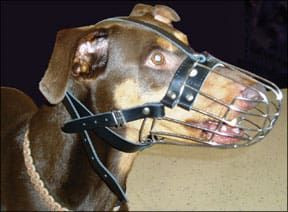[Updated January 31, 2019]
TRAIN YOUR DOG TO WEAR A MUZZLE: OVERVIEW
1. Select the best muzzle for the task. Short sessions might call for a nylon muzzle, while more intensive work might require a basket muzzle.
2. Create a positive association to the muzzle before you need it.
3. If working with a behavior professional, veterinarian, etc. consider asking them ahead of time if she has a preference for the type of muzzle you use.
4. Don’t use a muzzle as a substitute for working on problem behaviors.
Long thought to be a sign of a “bad dog,” muzzles are more commonly seen today on ordinary pet dogs who are being proactively managed by a smart owner! But our guess is that many of our readers haven’t given a second thought to introducing a muzzle to their precious pooches. In reality, it would behoove all of us to consider purchasing a muzzle and familiarizing our dogs to it before we’re put into a situation of having to use one.
Why Get Your Dog A Muzzle?
Can’t imagine why your dog might need a muzzle? Consider the following:
• Routine veterinary visit. Face it, some of our dogs just do not like to be handled. Bing, a Belgian Sheepdog belonging to Ali Brown, trainer and author of Scaredy Dog! and Focus Not Fear, doesn’t like people touching him. So she free-shaped him to accept (read: love) a nylon muzzle, and now he wears one for veterinary visits, chiropractic adjustments, and grooming appointments.
• Medical emergency and/or emergency veterinary visit. No matter how sweet, a dog in pain can bite. A muzzle can be a lifesaver if your dog has a critical injury and needs medical help. Chances are good that the emergency vet staff might want to muzzle your dog. Two years ago when we thought that Axel, my large Bouvier, was bloating, the ER vet told us that he’d be muzzling Axel as a precaution during the exam. Although I wasn’t thrilled – Axel was a highly regarded therapy dog – I relented, putting myself in the shoes of the vet who was dealing with a “scary” large breed dog whom he didn’t know, and one who was possibly in a great amount of pain. (Note: no bloat!)
Photo by Pete Smoyer

• Grooming. Angela Duckett, who’s been grooming professionally for 15 years, with another 15 years under her belt as an assistant to a professional handler and breeder (as well as her mom!), has no objections to grooming a dog who requires a muzzle. “A few of my clients need one during the entire groom, while others need it just for things that don’t feel good (i.e., nails, ears),” she says. Muzzling a dog allows her to pay more attention to the dog and getting the groom right, rather than having to watch the dog’s face the whole time to see if he’s getting ready to nip.
Duckett differentiates between dogs who “argue” about being muzzled and those who panic. If the dog takes the muzzle and lets her touch him, she’ll proceed. But should a dog physically fight or become frantic when muzzled, she stops the session, calls the dog’s owner and recommends another avenue for grooming such as a mobile groomer, or the veterinarian.
• Discouraging picking up, chewing, and eating of foreign objects. While better management and training (i.e., “Give,” “Drop it,” “Leave it”) are the preferred methods of dealing with a dog who picks up inappropriate foreign objects, a muzzle can come in handy if you’re trying to rule out ingestion of “stuff” as the cause of a medical problem.
For some time, my dog Axel was having blood in his stool. He also routinely picked up and chewed small wood chips and sticks while in the backyard, even under a close watch. Before making him submit to an invasive medical procedure (endoscopy), I wanted to rule out that his grazing wasn’t at the root of the problem. For a week or two, he wore a basket muzzle any time he was off-leash outside. This allowed him the freedom to move about without me breathing down his neck, while giving me peace of mind that he was not ingesting forbidden fruit. Pica was ruled out as a reason for his problem.
• Traveling on public transportation. In some enlightened U.S. cities such as Boston, leashed dogs are allowed to travel on public transportation with their people. Depending on the locale, certain rules and regulations apply. In Europe, it is the rule, rather than the exception, to allow dogs on public transport. Some cities permit leashed dogs on public transportation without being muzzled, although some systems, such as the water taxis in Venice, Italy, require dogs to be muzzled during travel, or, at the least, that the dog’s owner carry a muzzle should it be required.
• Certain introductions. A muzzle can provide an insurance policy in some unknown situations. For example, in the case of a dog who has killed cats, and is being considered by a potential adopter who already owns a small dog, a muzzle could be used to ensure the safety of the small dog during a carefully orchestrated “meet and greet.”

WDJ training editor Pat Miller would consider the use of a muzzle on a dog-aggressive dog for meeting other dogs, but only after significant training and behavior modification work has progressed to the point that interaction might be appropriate. At that time, a well-desensitized muzzle might be called for as an extra precaution.
• Aggression cases. If your dog is aggressive toward people and you are seeking the assistance of a behavior professional, s/he might require your dog to be muzzled during the consult.
For consults with the University of Georgia Veterinary Behavior Service, for example, Sharon Crowell-Davis, DVM, PhD, Diplomate American College of Veterinary Behaviorists, explains that, “Aggressive dogs that come to the behavior service and present a risk of injuring hospital personnel, other clients or other patients are required to wear a basket muzzle. Clients are given instructions on how to get a correctly fitted basket muzzle, which allows the dog to pant, bark, drink, and take treats offered through the basket muzzle. They are also educated in how to train their dog to readily accept the muzzle.”
While some trainers offer “growl” or reactive dog classes that require the participants (the dogs, that is!) to be muzzled, Pat Miller and Ali Brown both independently offer reactive dog classes and workshops, and are not fans of muzzling the dogs in class. Their sessions focus on working the dogs sub-threshold, getting them to be relaxed and calm and able to control their own behavior in the “reasonable” presence of other dogs; the intent is not to ask the dogs to interact with each other or to work super-threshold.
When Not to Put a Muzzle on Your Dog
Pat Miller warns that, with aggressive dogs, the purpose of a muzzle is not to give free rein to the dog and therefore repeatedly push the dog past his threshold, exposing the dog to stimuli that could and should be avoided. Likewise, Faye Owen of Animal Harmony, LLC, reminds us that “Any type of muzzle can be dislodged with a really intently aggressive dog or during an attack, so a muzzle should not be worn as a ¡®cure all’ for aggression.”
We have also seen advertisements advocating the use of muzzles to prevent or control barking and believe this to be an irresponsible use of a muzzle.
Types of Muzzles
We found muzzles ranging in price from a few dollars to more than a hundred, and from tiny, flimsy nylon muzzles to custom-made leather super-muzzles used for sport and police work. The type of muzzle you introduce to your dog will largely depend on how you plan to use it; our focus is on types suitable for pet dogs in the situations mentioned above. When purchasing a muzzle, fit, durability and comfort are the key determinants to making the right choice.
Cloth Muzzles
Cloth muzzles are typically very simple and usually made from nylon. They feature a band of fabric that envelopes the dog’s muzzle and two straps with a quick release that buckles up behind the dog’s ears. Offering a fairly snug fit, this is the type of muzzle most commonly used for handling issues, and is typically used by groomers and veterinarians for ease of use, comfort, light weight, and affordability.

Dogs have limited ability to pant and cannot readily drink water while wearing this style of muzzle. They might be able to take treats, but not easily, so Samantha Fogg of Work + Play Positive Dog Training recommends using baby food in a syringe to administer food. Because the dog cannot pant very well in this style of muzzle, it is imperative not to leave it on the dog for prolonged periods of time.
We checked out the Kwik Klip Nylon Muzzle ($10), and the tongue-in-cheek Happy Muzzle ($20) made in the U.S. and sold by Dog in the City of San Francisco. The Kwik Klip, in basic black, is a standard nylon muzzle; it offered a rim of padding around the edge of the muzzle where it contacts the dog’s face. The Happy Muzzle is available in a variety of bright patterns, which make the muzzled dog look less threatening, reducing the Hannibal Lecter effect. It is manufactured from heavy duty Cordura, and is water resistant and machine washable. It offered a little more substantial padding around the nose and just felt like a more robust muzzle.
I did a “pant test” with my Bouviers, putting each muzzle on them after a walk while they were panting. Both muzzles pretty much closed their mouths, limiting them to breathing through their noses. I didn’t like that there was little to no air flow around the muzzle.
Happy Muzzle literature explains that, “Panting is a necessary way of self cooling, so while dogs can easily breathe and drink water with the muzzle on, the Happy Muzzle is meant to be worn for periods of time not to exceed 90 minutes, particularly in hot weather.” Happy Muzzle or not, I would be hesitant to leave this style of muzzle on a dog for an hour and a half. I could not easily slip treats into their mouths. Also, some dogs can still nip while wearing this style of muzzle.
For a nylon muzzle, details you’ll want to pay attention to include weight and strength of the material, stitching, how well the straps are attached, and the quality of the buckle. And, of course, the muzzle is only as good as the fit. Sizing for each is fairly straightforward; simply measure the widest part of the muzzle and find the closest size. Both models are available in eight sizes. My vote in a nylon muzzle, for a few extra dollars, is to go with a product such as the Happy Muzzle which appears to be more durable and well-made than a basic nylon model.
Two additional cloth muzzles to mention are the ProGuard Softie and Tuffie muzzles. These are made from a “patented DuPont fabric” (read: fancy nylon) and offer more coverage than a traditional nylon muzzle, almost mimicking a basket style muzzle.
On the Softie, mesh material covers the dog’s nose and mouth, while the front of the Tuffie is solid fabric, with mesh on the sides. It appears that this design attempts to combine the comfort of a soft muzzle with the coverage of a basket, and I suppose for some folks it works. My primary concern is lack of air flow, and I’d personally opt for a wire basket style in lieu of this one.
Basket Muzzles
Basket muzzles are just that: a wire or plastic catcher’s mask-like cage that fits over the dog’s muzzle, and has at least one strap that clasps behind the dog’s ears; some models also feature a forehead strap which extends from the muzzle, reaching over the dog’s forehead, attaching to the neck strap for a super-secure fit.
All of the trainers we queried favored the basket muzzle, though they admitted they tend to use nylon muzzles often in practice simply because of ease of use. It also appears that desensitization to a basket muzzle might take a little more time simply because of its size. Although veterinarians with whom I spoke typically use nylon muzzles in their practices, they are not averse to clients using basket muzzles.

Basket muzzles better allows dogs to pant, more easily take treats (small ones work best), and drink water, and provide better ventilation than a nylon muzzle. For those reasons, the basket muzzle is favored for dog-dog interactions, although Samantha Fogg is quick to point out that a big dog in a basket muzzle can still damage a little dog just from the force of a muzzle punch, so precautions need to be taken.
The Italian Basket Muzzle retails for just under $20, depending on the size, and is favored for its lightweight and flexibility. The basket part is made from flexible polyethylene (plastic) while the adjustable buckle strap is leather. When I tried it out on my dogs, they could more easily pant, though still not a full on open mouth pant. Getting treats into their mouths was a little tricky, which is where the “small treat” part comes in to play, I suppose. The front of the muzzle features an extra removable grill; without it in place, treat delivery is a little less tedious.
Although the muzzle comes fairly high up on the bridge of the dog’s nose, just under the eyes, I can see how a really determined dog might be able to dislodge the muzzle, though it would take lots of work. There is a thin layer of leather that lies between where the muzzle hits the dog’s face and the muzzle. I imagine extra padding with something like moleskin might make for a more comfortable fit.
Some basket muzzles allow the user to thread the dog’s collar through the attachments for the neck strap for a more secure fit, but that is not possible on this model. There are a number of sizes available and a few measurements to take to get the right size. This model is not recommended for flat or pug nose breeds. I would use this for some applications, but probably not for a serious aggression case.
The Heavy Duty Wire Basket Muzzle is just that: heavy duty. The basket part of the muzzle is made from chrome wire, and the straps a little more substantial leather than those on the Italian basket model. The part of the muzzle that contacts the top of the dog’s muzzle is lined with a thick piece of leather, with additional padding under it. The #5 size that we tested weighed about 8 ounces, or about twice as much as the Italian Basket muzzle size 8.
The model we looked at came with a forehead strap. It would be much more difficult – though maybe not impossible – for an intent dog to dislodge the muzzle with a forehead strap attached.
Apparently not all sizes come with this strap; it appears that it’s used primarily on models for short-nosed breeds. Perhaps because my dogs are used to having hair on their faces, they easily accepted wearing this style of muzzle. A shorter haired breed might prove more sensitive to the extra weight, so proper desensitization is necessary.
I liked that this model seemed to have extra room in the basket for panting and air flow, and of course, room to take treats. This model retailed for $33 and is available in 17 sizes, based on length and circumference of the dog’s muzzle. This would be my choice for a more serious aggression case or for those instances when you really want peace of mind.
In terms of weight and sturdiness, mid-way between the Italian Basket and the Heavy Duty Wire Basket is the Plastic Coated Wire Basket Dog Muzzle. It is a little heftier than the Italian Basket, but less robust than the Heavy Duty Wire Basket, so not quite as heavy, and retails for about $22. I used this model when I was trying to keep Axel from ingesting foreign objects, and it worked well. The basket is a light-weight wire covered in plastic.
How to Condition a Positive Emotional Response to a Muzzle
Trainers often use the term “desensitization” when talking about introducing your dog to a new piece of equipment, such as a muzzle. In reality, when it’s something new, you’re conditioning your dog’s initial response to the new object. The desensitization procedure applies when your dog already has an association with the object — usually a negative one — and you’re working to change the association to positive.
It’s a lot easier (and wiser) to start by creating a positive association with a muzzle for your dog (or any other stimulus!) than it is to have to backtrack and create a new one. You’ll have the most success if you and your dog can make a game of it rather than getting all worried and serious. Be upbeat and cheerful rather than serious or worried, and encourage your dog to be playful as you do this.
Your goal is to convince your dog that “muzzle = good stuff!” You know how your dog’s eyes light up when you pick up her leash, her ball, or her favorite tug toy? That’s what you want to see when you pick up her muzzle. Feel free to incorporate the clicker to mark your dog’s behavior as soon as she starts offering deliberate muzzle-related behaviors.
Start by purchasing an appropriately-sized basket muzzle. Work with your dog, in several short sessions (5-15 minutes) throughout each day — the more short sessions, the better! Here are the steps of a sample conditioning protocol:
1. Hold up the muzzle, feed your dog a high value treat. Repeat this step until your dog brightens and looks for the treat when you hold up the muzzle.
2. Let your dog sniff the outside of the muzzle (or invite her to target to it) and feed a treat. Repeat until she’s happily offering to sniff’/target and then looking for her treat.
3. Invite her to sniff/target the edge of the muzzle opening. Feed a treat. Repeat until she’s happily offering to sniff/target, then looking for her treat.
4. Encourage her to put her nose into the muzzle opening by sticking a treat to the inside, near the opening. Repeat until she’s eagerly putting her nose into the opening, then gradually move the treat deeper into the muzzle, with numerous repetitions at each new increment, until she’s happy to put her nose all the way in.
5. Increase duration by feeding several treats each time while her nose is all the way in, gradually increasing delay between treats, until she’ll voluntarily hold her nose in the muzzle for 5-10 seconds waiting for the next click and treat.
6. While she’s holding her nose in the muzzle, clip the strap behind her head, click, treat, and release the strap. Gradually increase the length of time you leave the muzzle clipped on, with random reinforcement, and you’re done!
If at any time during the protocol your dog resists the muzzle, back up to a point where she’s happy again, and proceed more slowly. When you have completed the process and your dog is happy to wear her muzzle, be sure to play muzzle games with her from time to time to maintain the positive emotional response. If you put it on her only when she’s going to see the vet, you can poison the association you worked so hard to attain.
Before You Buy
With the exception of the Happy Muzzle, we bought the muzzles we tested at Morrco.com, but most pet supply stores and online retailers carry muzzles. To buy the basket muzzles we tested, see morrco.com or call the business at (800) 575-1451. To buy the the Happy Muzzle, call (415) 861-4724 or see doginthecity.net.
Remember that flat or pug nose dogs require special sizing, and will even most likely do better with certain styles than others. If in doubt, consult with your trainer or veterinarian. If purchasing a muzzle to use at vet visits, ask your dog’s veterinarian first if s/he has a style preference.
And above all, use common sense when desensitizing and using a muzzle. Don’t keep it on your dog for extended periods of time, never leave one on an unsupervised dog, and don’t use it as an excuse to expose your dog to situations that you shouldn’t be placing him in.
Lisa Rodier lives in Alpharetta, Georgia, with her husband and two Bouviers. She is also a volunteer with the American Bouvier Rescue League.






